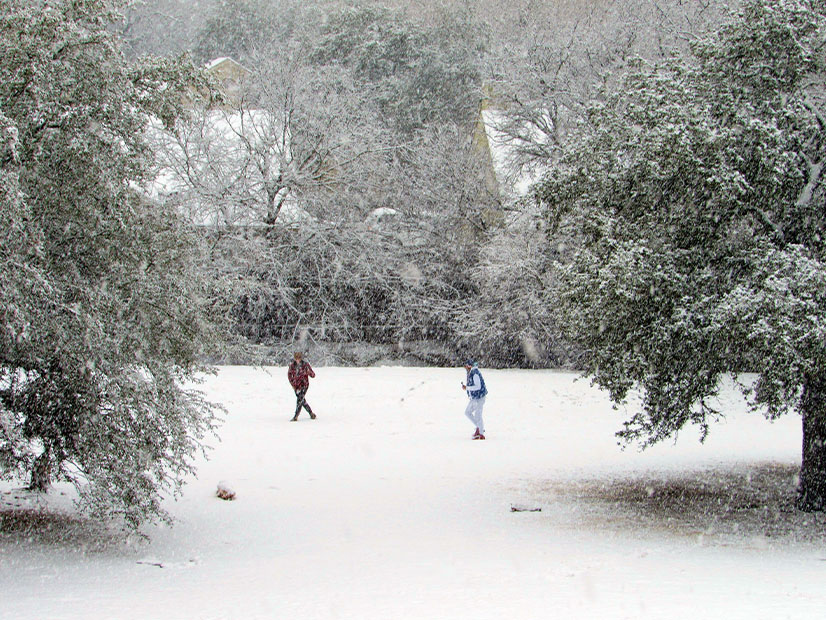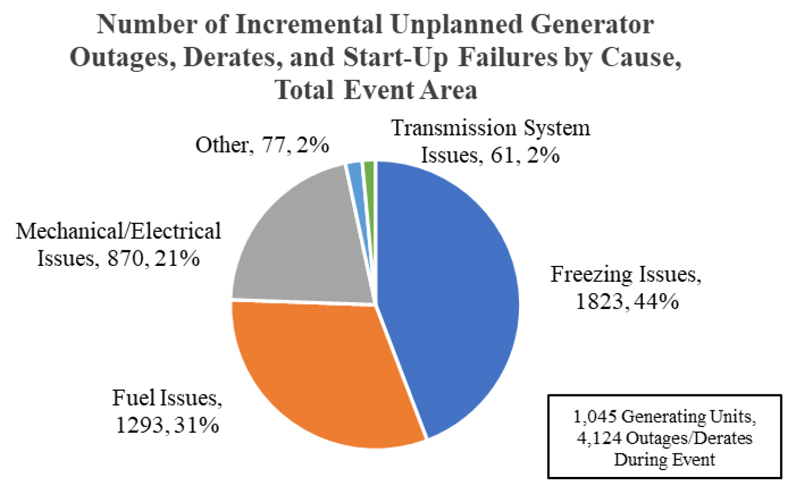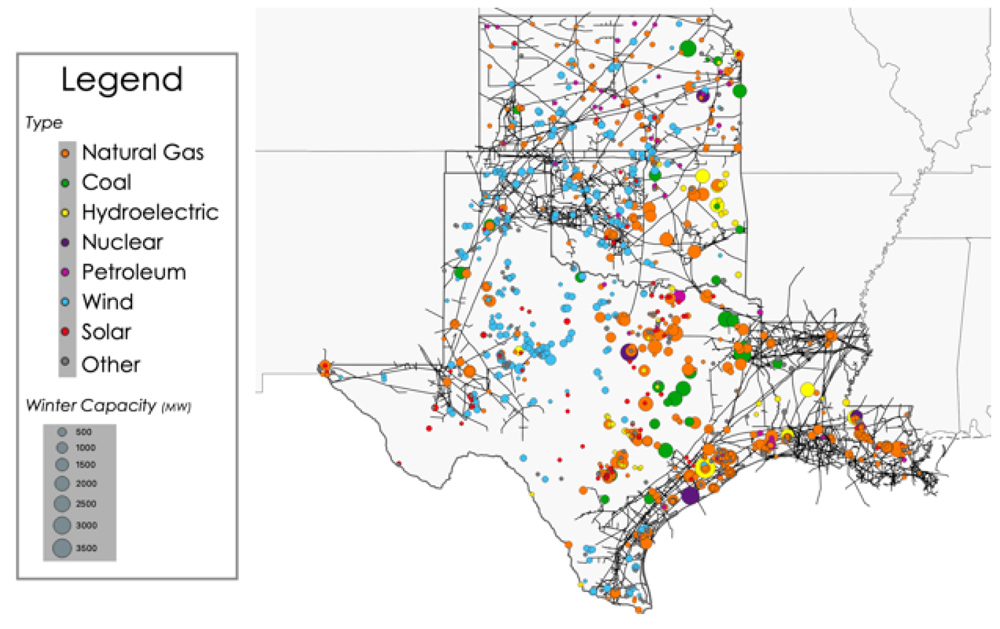
FERC and NERC’s final report on February’s winter storms in Texas and the South Central U.S., issued on Tuesday, is a “sobering analysis that highlights the significant work that needs to be done” to prepare the electric grid for future cold weather events, according to FERC Chairman Richard Glick.
 Incremental unplanned generating unit outages, derates, and failures to start for the total event area, by cause, fuel type, and MW of nameplate capacity | FERC
Incremental unplanned generating unit outages, derates, and failures to start for the total event area, by cause, fuel type, and MW of nameplate capacity | FERCThe report, released nine months to the day after the commission announced it in the middle of the 12-day crisis, detailed how the severe cold impacted bulk electric system reliability, leading to widespread generation outages, derates or failures to start and forcing more than 23,000 MW of manual firm load shed. (See “FERC, NERC Announce Joint Inquiry,” Slow Storm Restoration Sparks Anger in Texas, South.) Residents of several cities were ordered to boil drinking and cooking water because of lack of power for water treatment plants, and multiple deaths occurred from hypothermia, carbon monoxide poisoning and heating fires that grew out of control.
ERCOT, in whose territory the crisis was most severe, has not yet provided a response to the report. In an email to RTO Insider, SPP said it is “currently evaluating” the joint report while also plugging its Improved Resource Availability Task Force, which is working to “address recommendations found in” the commission’s preliminary report. (See FERC, NERC Share Findings on February Winter Storm.)
The preliminary report, issued at the commission’s open meeting in September, highlighted the role of natural gas supply disruptions in the outages and listed recommendations for preventing another disaster. Tuesday’s report provided the same overall conclusions but with more detailed data and recommendations.
Gas Accounted for Most Outages
The report showed that all types of generation experienced failures in the cold weather event, but the greatest share of outages by far occurred among natural gas facilities. Both in terms of the number of units that experienced unplanned outages, derates and failures to start, and in their total nameplate capacity, gas units accounted for more than 50%. Next in both categories was wind, accounting for 27% of generating unit outages and 22% of total capacity. Coal came third, with 6% of generating units and 18% of capacity.
 Location and fuel type of unplanned generation outages and derates during the event (outaged capacity in MW) | FERC
Location and fuel type of unplanned generation outages and derates during the event (outaged capacity in MW) | FERCFreezing issues caused 44% of the generating unit problems, which the report blamed on the facilities being unprepared for cold temperatures, wind and freezing precipitation. These conditions caused certain components and systems to freeze; for example, transmitters, sensing lines and instrumentation, valves and inlet air systems, and wind turbine blades. The report found many of the generator outages — 67% in ERCOT, 47% in SPP and 55% in MISO South — could have been avoided if these components had been properly prepared for the freezing weather.
Another major cause of generator outages was fuel issues, at 31%, of which natural gas alone accounted for 87%, with other fuels such as coal or fuel oil making up the rest. The issues with natural gas included drops in production and low pipeline pressure because of cold-related equipment failures, and the “terms and conditions of natural gas commodity and transportation contracts” that caused gas needed for electric generation to be prioritized for heating instead.
An additional 21% of generator outages were caused by mechanical and electrical issues. These were also from the cold, but they were not classed under “freezing issues” because the temperature did not reach freezing. The report’s authors once again laid the blame squarely at the feet of registered entities that failed to prepare their systems for the coming cold.
“Despite multiple prior recommendations by FERC and NERC, as well as annual reminders via regional entity workshops, that generating units take actions to prepare for the winter (and providing detailed suggestions for winterization), 49 generating units in SPP … 26 in ERCOT … and three units in MISO South still did not have any winterization plans,” the report said.
Report Urges Serious Cold Weather Prep
Recommendations provided in the report include significant changes to NERC’s reliability standards, requiring generator owners and/or operators to:
- identify and protect cold weather-critical components;
- build new or retrofit existing generating units to operate to specific ambient temperatures and weather based on extreme temperature and weather data, and account for effects of precipitation and wind;
- perform annual training on winterization plans;
- develop corrective action plans if freeze-related outages have been experienced in the past;
- provide balancing authorities with the percentage of the total generating unit capacity that can be relied on during local forecasted cold weather; and
- account for the effects of precipitation and wind when providing temperature data to balancing authorities.
NERC recently passed a set of cold weather standards, but that project began before February’s winter storm and was not intended to address any specific problems from that event. (See FERC Approves Cold Weather Standards.) The organization is attempting to initiate another cold weather standards project, but the Standards Committee last month decided to wait until the final report was issued before taking action. (See NERC Standards Committee Delays Action on Cold Weather SAR.)
 Interdependency of electric and natural gas infrastructure in Texas and the South Central U.S. | DOE
Interdependency of electric and natural gas infrastructure in Texas and the South Central U.S. | DOE
The report also recommended that generator owners be compensated for the costs of retrofitting their existing units, or designing new units, to withstand specified ambient temperatures, and that FERC, NERC and the REs host a joint technical conference to “discuss how to improve the winter readiness of generating units before [NERC’s] reliability standard revisions become effective” in 2023.
In addition, in light of the interdependencies between the gas and electric sectors and the vulnerabilities in this area exposed by the storm, the team urged Congress, state legislatures and regulatory agencies to require natural gas facilities to implement and maintain cold weather preparedness plans. It also recommended that the facilities themselves “undertake voluntary measures to prepare for cold weather” and that generator owners and operators “identify the reliability risks related to their natural gas fuel contracts.”



